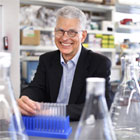Rodger P. McEver, MD, Oklahoma Medical Research Foundation

In Dr. McEver's lab they study how circulating blood cells attach to blood vessel surfaces at sites of tissue injury or infection. Substances released at these sites direct the endothelial cells that line blood vessels to display â??adhesion molecules.â? These molecules enable circulating white blood cells, or leukocytes, to roll along the vessel surface. The rolling cells then slow to a stop and then crawl between the endothelial cells into the tissues, where they destroy invading microbes. This process is known as inflammation. Similarly, circulating platelets use adhesion molecules to roll along tissues that are exposed when blood vessels are disrupted. The platelets then stop and form clumps to slow hemorrhage and promote blood clotting. Inflammation and blood clotting are often linked. Indeed, leukocytes sometimes roll on and then stick to blood platelets. Excessive inflammation and blood clotting contribute towards many diseases, including heart attacks, stroke, dysfunction of transplanted organs, deep vein thrombosis, and sickle cell crisis.
Products
References
- Patel KD, Moore KL, Nollert MU, McEver RP. Neutrophils use both shared and distinct mechanisms to adhere to selectins under static and flow conditions. J Clin Invest. 1995 Oct;96(4):1887-96. PubMed PMID: 7560080; PubMed Central PMCID: PMC185825.
- McEver RP, Baenziger NL, Majerus PW. Isolation and quantitation of the platelet membrane glycoprotein deficient in thrombasthenia using a monoclonal hybridoma antibody. J Clin Invest. 1980 Dec;66(6):1311-8. PubMed PMID: 6449521
- McEver RP, Bennett EM, Martin MN. Identification of two structurally and functionally distinct sites on human platelet membrane glycoprotein IIb-IIIa using monoclonal antibodies. J Biol Chem. 1983 Apr 25;258(8):5269-75. PubMed PMID: 6220015.



